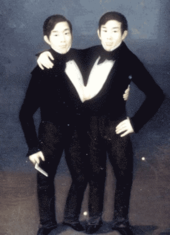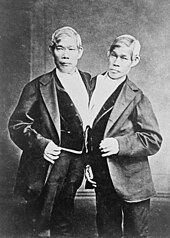Chang and Eng bunker
Chang and Eng Bunker ( Thai จัน อิน บังเกอร์ , pronounced [ t͡ɕan ] and [ʔiŋ] ; * May 11, 1811 in Tambon Mae Klong, Samut Songkhram Province in Siam , today Thailand ; † January 17, 1874 ) were Siamese twins who were born with this Gave birth to malformation.
Origin and life
The brothers were born to Chinese parents in Siam and were joined on the sides of their bodies. They were discovered in 1829 and presented as a sensation at annual fairs . In 1839, they settled in Wilkesboro , became US citizens, and took the name Bunker . They married two sisters, Adelaide and Sarah Yates, in 1843 and together had 21 normally developed children, 11 of whom became adults. It is reported that Chang developed a penchant for alcohol and that the wives occasionally quarreled, which is why separate households were set up and the twins alternately lived in the house of one or the other wife every three days.
Career and death
A British merchant, Robert Hunter, and an American sea captain, Abel Coffin, arranged a two-and-a-half-year exhibition tour of the twins through the United States and Great Britain from 1829 to 1831. Chang and Eng then took over their own businesses and earned money in the next forty years made a living as an entertainer . In 1870 they were seen for the first time in Germany. During this stay, they also had Rudolf Virchow examine them with a view to separating them. Virchow believed in a successful separation, which then did not come to fruition.
On the way back from a tour to Russia in 1870, Chang Bunker suffered a stroke and remained paralyzed; His physical support became narrow for the next three years until they died together on January 17, 1874 at the age of 63. With the widows' consent, an autopsy was performed in the Mothers Museum of the College of Physicians in Philadelphia , the report of which has been preserved with drawings of the fused tissues. Accordingly, the two had only grown together and had no vital organ in common. A separation, as suggested by Virchow, would have been possible.
literature
- Hans Scheugl : Show Freaks & Monsters. Felix Adanos Collection . 3. Edition. DuMont Buchverlag, Cologne 1978, ISBN 3-7701-0733-0 , p. 109f. with fig.
- Hillel Schwartz: Déjà vu. The world in the age of its actual reproducibility . Aufbau-Verlag, Berlin 2000, ISBN 3-351-02500-9 , p. 49ff.
Web links
- Literature about Chang Bunker in the catalog of the German National Library
- Literature about Eng Bunker in the catalog of the German National Library
- US National Library of Medicine: From "Monsters" to Modern Medicine Miracles (accessed August 11, 2012)
- ZeitZeichen : 01/17/1874 - anniversary of the death of Chang and Eng Bunker
Individual evidence
- ↑ According to the US National Library of Medicine: From "Monsters" to Modern Medicine Miracles (accessed August 11, 2012): 21 children together, 11 of whom survived; Scheugl (1978) gives the number of 18 children.
- ^ Hans Scheugl: Show Freaks & Monsters. Felix Adanos Collection . DuMont publishing house: Cologne, 1978; P. 109
- ↑ US National Library of Medicine: From "Monsters" to Modern Medicine Miracles (accessed August 11, 2012)
- ↑ Scheugl (1978), p. 109
- ↑ Springermedizin.at ( Memento from February 1, 2014 in the Internet Archive )
- ↑ US National Library of Medicine: From "Monsters" to Modern Medicine Miracles (accessed August 11, 2012)
- ↑ Springermedizin.at ( Memento from February 1, 2014 in the Internet Archive )


